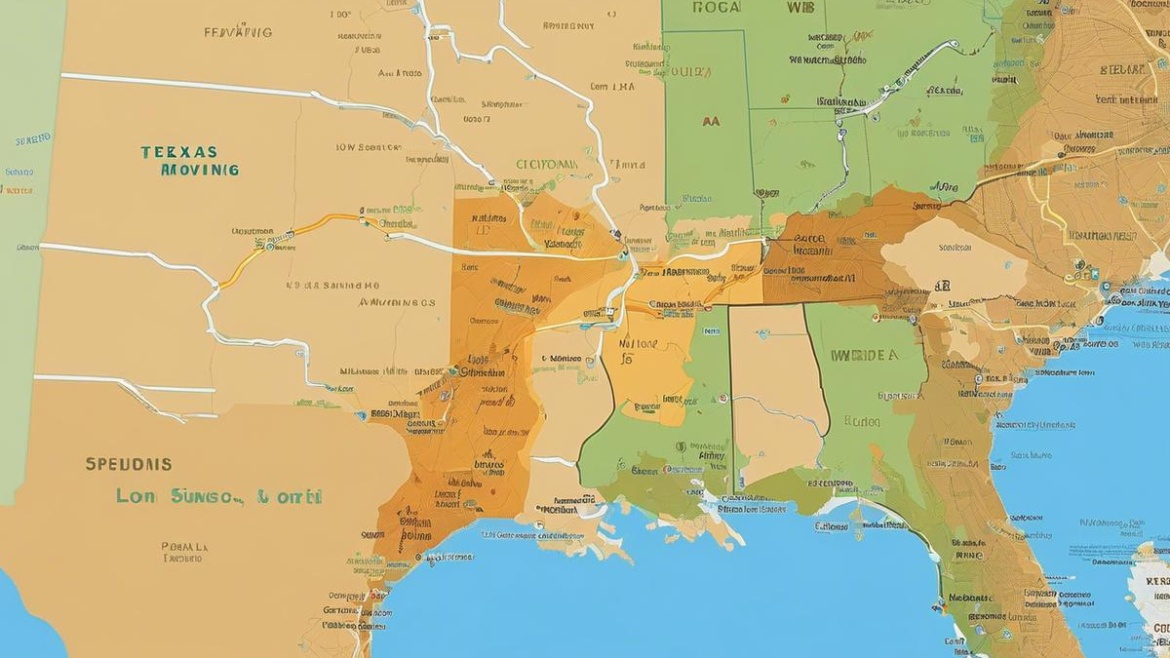In an increasingly mobile society, one particular corridor of America is seeing a surge in long distance moving – Texas to Florida. As two of the country’s most populous and economically dynamic states, they offer significant opportunities and challenges for the moving industry. This essay delves into the fascinating world of long-distance moving between Texas and Florida, providing a comprehensive view of the sector from market dynamics to the cutting-edge services reshaping customer experiences. Whether you’re a prospective mover, an industry investor, or a curious reader, this exploration will equip you with crucial insights into this evolving industry, the players defining its landscape, and its likely trajectory in the near future.
The Market Dynamics of Long Distance Moving
Disruptive Market Dynamics Impacting the Texas-Florida Long Distance Moving Industry
In the fast-paced world we inhabit, transitions have become part and parcel of life. As people continuously relocate in search of new opportunities, one industry that’s witnessing robust growth is the long-distance moving domain. Intriguingly, the Texas-Florida axis has experienced unprecedented surge recently, presenting a fertile ground for entrepreneurs. Consequently, understanding the factors impacting this trajectory is imperative for businesses.
Let’s delve into some crucial market dynamics shaping this sector.
- Demographic Shifts: There’s a substantial population in flux from Texas to Florida. Retirees seeking a sunnier, tax-friendlier state or professionals chasing growth opportunities contribute to this shift. The resultant demand for moving services mandates businesses to innovate and stay competitive.
- Economic Health: The economic vitality of both states plays an instrumental role. Recession diminishes relocation rates profoundly, while a booming economy attracts workers seeking job opportunities. Hence, keeping a pulse on the economy could sway decision-making for businesses.
- Technological Advancements: The digital revolution has made inroads into the moving industry too. Consumers today demand easy quotes, online tracking, and efficient service. Companies harnessing technology effectively can steer ahead of the competition.
- Regulation Changes: Both the states have differing regulations that potentially affect the moving industry. For example, Texas’s rather lenient regulations against Florida’s stricter ones create a contrasting business environment. Hence, staying updated and adapting to these unpredictability becomes crucial for companies.
- Climate Change: Unexpected but true, the increasing severity of storms and hurricanes in Florida can negatively impact the moving schedules and increase expenses relating to damages. Companies must account for these unforeseen hindrances into their strategic calculus.
- Real Estate Trends: The real estate markets drive the long-distance moving industry. A booming housing market, combined with attractive mortgage rates, can trigger mass relocations, spurring growth in this sector. Businesses must keep abreast with the housing trends to align services accordingly.
- Expansion and Diversification: With a growing market, companies have a unique chance to diversify their services. Offering packing, storage, or insurance can open new revenue streams. Smart entrepreneurs are quickly capitalizing on these opportunities to build a diverse, robust portfolio in this sector.
In this era of rapid change, staying perceptive and proactive is the mantra for success. Although these dynamics are challenging, they also present exciting opportunities. The key is to keep evolving and innovating, and the Texas-Florida long-distance moving market is no exception to this rule.

Innovative Services in the Moving Industry
Let’s take a closer look at the vibrant landscape of moving industry innovations, those trendsetting services that are remaking the way we relocate from the Lone Star State to the Sunshine State.
One cannot discuss the moving industry without mentioning on-demand services, a cutting-edge trend that has disrupted multiple sectors, from ride-sharing to food delivery. Creative start-ups are capitalizing on this consumer behavior shift towards speed and convenience. One such innovation I want to spotlight is mobile apps that connect consumers requiring relocation services to moving companies. These digital platforms, with their quick quotes and real-time tracking, have revolutionized customer experiences, effectively solving service quality and reliability issues.
Now, have you heard about eco-friendly moves? Today’s entrepreneurs are ever conscious of the need for sustainability, propelling the advent of green moving companies. These businesses provide reusable plastic moving boxes, reducing the waste generated from one-time use cardboard boxes. They are also endorsing bio-diesel trucks as a cleaner, more ethical way to transport possessions, reducing the carbon footprint. This confluence of innovation and sustainability not only benefits the environment but also positions companies as conscious, responsible leaders in the industry.
Then there’s the trend of bundled services, a smart business strategy fulfilling multiple customer needs at once. Companies now offer concierge services, like home cleaning, debris pickup, and even home setup and organization services, in addition to moving. This not only diversifies the revenue streams of the company but adds immense value to customers who value a seamless, stress-free move.
Next up is the surge in the use of AI and machine learning algorithms. Companies are utilizing these advanced tech tools to better estimate moving costs, optimize routing and logistics, and significantly enhance their operational efficiency. Smart scheduling, another by-product of AI application, maximizes workforce productivity by improving job scheduling accuracy.
Lastly, there’s no argument that the gig economy and shared economy concepts have swept through various industries. They’re making a foothold in the moving industry too, linking job seekers with moving assignments. It’s a win-win situation where moving companies address fluctuating demands more efficiently, and job seekers get flexible options to earn.
Such impressive innovations evidently highlight the breadth and depth of entrepreneurial intellect at work in the moving industry. It underscores the adaptability of businesses to socio-economic trends and technological shifts. And as a result, they are traversing new routes to profitability and customer satisfaction, all while redefining what moving from Texas to Florida entails.

The Future of the Moving Industry
The long-distance moving sector, particularly from Texas to Florida, is evolving rapidly in response to dynamic needs and expectations of consumers.
In a world where disruption is not only expected but frequently celebrated, those who anticipate and capitalize on upcoming trends often enjoy a sprint ahead of the competition. Keeping the finger on the pulse of these upcoming trends is key to maintaining a forward-leaning organisation in a rapidly evolving industry.
Hinging on the several discussed in previous sections, there are a couple of other developments one should be attentive to that promise to further shape the moving industry landscape.
Firstly, understanding the cultural shifts in our society could be the make or break for a business looking to remain competitive. Broadly encompassing lifestyle changes, cultural swings point towards the growing trend of minimalism. More and more individuals are opting for less clutter and more mobility. This lifestyle trend could potentially reduce the moving industry’s core service – the transportation of large amounts of goods over long distances. However, nimble businesses can pivot to provide specialized moving services or supplementary services such as space planning or furniture assembly.
Another significant factor that could shape the future of the moving industry is the evolution of remote work possibilities. Many corporations have accepted remote work as a part of their long-term strategy in the light of the recent pandemic. With this newfound employment flexibility, consumers have more freedom to relocate, and this could drastically increase the potential moving opportunities from Texas to Florida.
Next is the integration and overall acceptance of cryptocurrency. The moving industry is not immune to this digital money revolution. Accepting cryptocurrencies, such as Bitcoin, as a form of payment could invite a wider customer base and enable smoother long-distance transactions. The agile entrepreneurs could also consider blockchain technology to improve accountability and transparency in contractual agreements with customers.
Lastly, a trend that holds promise for the moving industry – autonomously driven vehicles. Automating long-distance haulage could significantly reduce operation costs, albeit not without regulatory, societal, and technological challenges. Once surmounted, this technology has the potential to revolutionize the moving industry, providing faster and more efficient services at a lesser cost.
Hence, with all the mentioned developments and trends, one thing is certain: the moving industry is far from stagnant. Whether these changing tides will be a boon or bane for long-distance moving companies from Texas to Florida largely depends on how they adapt and strategize. Savvy businesspeople who are adaptable, innovative, and resilient are likely to handle the emerging trends with aplomb and ride the waves of change towards success. The future belongs to them.

Emerging from this thorough exploration, it’s clear that the moving industry between Texas and Florida is far from stagnant. Continuous innovation, fueled by technological advancements, is revolutionizing services offered, improving efficiency and enhancing customer experiences. Moving businesses are not just adapting to changes but actively shaping them in their race to stay competitive. As we look ahead, market dynamics suggest that this sector will continue to thrive and evolve, presenting new opportunities and challenges alike. Through understanding the intricate weave of trends, market forces, and technological developments, one can navigate the complexities of this industry more confidently. This reflection on where we stand today and where we might be heading, consequently, serves as a valuable compass for anyone interested in the moving industry.

